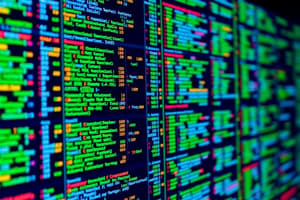Podcast
Questions and Answers
Ποιο από τα παρακάτω ανήκει στα κυριότερα στοιχεία της πολυμέσης στην επιστήμη των υπολογιστών;
Ποιο από τα παρακάτω ανήκει στα κυριότερα στοιχεία της πολυμέσης στην επιστήμη των υπολογιστών;
- Επεξεργασία Κειμένου
- Ανάλυση Κώδικα
- Επεξεργασία Ήχου
- Σχεδιασμός Βάσεων Δεδομένων
Τι περιλαμβάνει η επεξεργασία εικόνας στην πολυμέσα στην επιστήμη των υπολογιστών;
Τι περιλαμβάνει η επεξεργασία εικόνας στην πολυμέσα στην επιστήμη των υπολογιστών;
- Ανάλυση Ψηφιακών Εικόνων
- Κωδικοποίηση Κωδικών
- Σύνθεση Μουσικής
- Συμπίεση Κειμένου
Τι αφορά η οπτική υπολογιστών στην επιστήμη των υπολογιστών;
Τι αφορά η οπτική υπολογιστών στην επιστήμη των υπολογιστών;
- Αλγόριθμους Επεξεργασίας
- Χειρισμό Δεδομένων
- Ακουστική Επεξεργασία
- Ερμηνεία και Κατανόηση Οπτικής Πληροφορίας
Πώς αποκαλείται η δυνατότητα του υπολογιστή να αναγνωρίζει αντικείμενα και να καθορίζει μοτίβα σε εικόνες;
Πώς αποκαλείται η δυνατότητα του υπολογιστή να αναγνωρίζει αντικείμενα και να καθορίζει μοτίβα σε εικόνες;
Πώς αποκαλούμε τη διαδικασία εφαρμογής μαθηματικών αλγορίθμων στη διάχυτη επεξεργασία ψηφιακών εικόνων;
Πώς αποκαλούμε τη διαδικασία εφαρμογής μαθηματικών αλγορίθμων στη διάχυτη επεξεργασία ψηφιακών εικόνων;
Ποια είναι μια από τις εφαρμογές των πολυμέσων στην εκπαιδευτική και εκπαιδευτική εκπαίδευση?
Ποια είναι μια από τις εφαρμογές των πολυμέσων στην εκπαιδευτική και εκπαιδευτική εκπαίδευση?
Ποια τεχνική ασφάλειας πολυμέσων εξασφαλίζει την ακεραιότητα του περιεχομένου;
Ποια τεχνική ασφάλειας πολυμέσων εξασφαλίζει την ακεραιότητα του περιεχομένου;
Ποιος από τους ακόλουθους τομείς ΔΕΝ χρησιμοποιεί πολυμέσα για να προσφέρει ακριβείς διαγνώσεις και θεραπείες;
Ποιος από τους ακόλουθους τομείς ΔΕΝ χρησιμοποιεί πολυμέσα για να προσφέρει ακριβείς διαγνώσεις και θεραπείες;
Ποιο είναι ένα από τα μελλοντικά προβλήματα και τάσεις στους τομείς των πολυμέσων;
Ποιο είναι ένα από τα μελλοντικά προβλήματα και τάσεις στους τομείς των πολυμέσων;
Πώς μπορούν οι πολυμέσα να συμβάλουν στη δημιουργία ρεαλιστικών εμπειριών επαυξημένης πραγματικότητας και εικονικής πραγματικότητας;
Πώς μπορούν οι πολυμέσα να συμβάλουν στη δημιουργία ρεαλιστικών εμπειριών επαυξημένης πραγματικότητας και εικονικής πραγματικότητας;
Study Notes
Diving into Multimedia in Computer Science
From camera-equipped smartphones to virtual reality experiences and beyond, multimedia has revolutionized our digital world. In the field of computer science, multimedia encompasses techniques, algorithms, and technologies that enable the processing, representation, and delivery of multimedia content.
The Evolution of Multimedia in Computer Science
Multimedia has evolved tremendously since the introduction of the first digital images and audio files, primarily due to the advancements in computing power and storage capacity. As computer science progressed from text-based systems to graphical user interfaces, the demand for processing and delivering multimedia content increased, leading to the development of new algorithms and standards.
Key Components of Multimedia in Computer Science
- Image Processing: Utilizing mathematical algorithms to manipulate and analyze digital images, including techniques like compression, enhancement, and filtering.
- Computer Vision: The use of algorithms to interpret and understand the visual world, enabling machines to identify objects, track motion, and recognize patterns within images.
- Audio Processing: The use of algorithms to process and manipulate sound, including techniques like compression, synthesis, and recognition.
- Video Processing: The use of algorithms to process and manipulate digital video, including techniques like compression, enhancement, and analysis.
- Computational Photography: The use of computational methods to improve the quality and utility of photographs, including techniques like high dynamic range imaging and depth mapping.
- Multimedia Security: Ensuring the authenticity, integrity, and confidentiality of multimedia content, including techniques like watermarking and encryption.
Applications of Multimedia in Computer Science
- Digital Entertainment: From Hollywood blockbusters to mobile games, multimedia technologies drive the entertainment industry forward.
- Education and Training: Multimedia content is widely used in e-learning and training applications, as it enhances the learning experience and improves knowledge retention.
- Forensics and Security: Multimedia content can be used as evidence in forensic investigations, while multimedia security techniques help protect against unauthorized access and manipulation.
- Medical Imaging: Medical imaging technologies like CT scans, MRI scans, and ultrasounds rely on multimedia processing to provide accurate diagnoses and treatments.
- Augmented Reality and Virtual Reality: Multimedia content plays a crucial role in creating immersive augmented and virtual reality experiences.
Challenges and Future Trends
- Data Compression and Storage: The continued growth of multimedia content requires new compression techniques and storage solutions to manage the vast amounts of data generated.
- Content Creation and Editing: The rise of user-generated content and the need for real-time editing tools will drive the development of new multimedia creation and editing tools.
- Multimedia Analytics: The use of algorithms to analyze multimedia content for insights and patterns will drive innovation in areas like content recommendation and personalization.
- Hybrid and Synthetic Content: The use of hybrid and synthetic content, created using a combination of real-world images and computer-generated models, will become more common in applications like gaming and virtual reality.
As computer science continues to drive innovation in multimedia technologies, our experiences in the digital world will continue to evolve, transforming the way we communicate, learn, and interact with one another.
Studying That Suits You
Use AI to generate personalized quizzes and flashcards to suit your learning preferences.
Description
Test your knowledge on the evolution, key components, applications, and challenges of multimedia in computer science. Explore topics such as image processing, computer vision, multimedia security, and future trends in multimedia technologies.




